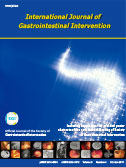
pISSN 2636-0004
eISSN 2636-0012
ABOUT THE IJGII
ARTICLE CATEGORY
ALL ARTICLES
For Contributors
-
POLICY



 pISSN 2636-0004
eISSN 2636-0012
pISSN 2636-0004
eISSN 2636-0012
 All Articles
All Articles
 Articles
Articles

 , Yasufumi Ohuchi, Akira Adachi, Masayuki Endo, Shohei Takasugi, Kazumichi Tsukamoto, Kensuke Matsumoto, Mika Kodani, Jun Makishima, and Shinya Fujii
, Yasufumi Ohuchi, Akira Adachi, Masayuki Endo, Shohei Takasugi, Kazumichi Tsukamoto, Kensuke Matsumoto, Mika Kodani, Jun Makishima, and Shinya FujiiAbstract : Transcatheter arterial embolization using N-butyl-2-cyanoacrylate (NBCA) for gastrointestinal arterial bleeding enables higher cessation rate and lower recurrent bleeding rate compared with conventional embolic materials including gelatin sponge, metallic coil, and polyvinyl alcohol (PVA) particle. Glue embolization is particularly effective in patients with coagulopathy. Even in the lower gastrointestinal tract, ischemic bowel complications by glue embolization are comparable to other agents. Glue embolization is also effective for arterial esophageal bleeding without any serious ischemic complications although the anatomy of the esophageal artery is complex and varied. For bleeding after abdominal surgery such as pancreaticoduodenectomy or hepatic lobectomy, interventional radiologists should be careful with indicating glue embolization because the presence of fewer collateral vessels can easily result in serious ischemic complications. Modified glue such as Glubran 2 (NBCA associated with methacryloxysulfolane) can reduce the risk of ischemic complication due to its less thermal reaction, but the outcomes seem unsatisfactory.
Cited By: 2

Abstract : Hemorrhage following pancreatitis may become complicated during the disease course and with possibly fatal consequences. Radiologic findings are as follows: the presence of hematomas, hemorrhagic pseudocysts, extravasation of contrast media or the formation of arterial pseudoaneurysms. The digital subtraction angiography findings are as follows: contrast extravasation due to arterial rupture; pseudoaneurysm formation; and luminal irregularity. A pseudoaneurysm is considered to be treated as soon as detected due to its risk of rupture. Endovascular management, which includes embolization using coils, N-butyl cyanoacrylate, gelatin sponge, stents, and thrombin, is an effective option for the treatment for pancreatitis-related bleeding.
Cited By: 0

Abstract :
Cited By: 6

 , Chun-Gao Zhou, Lin-Bo Zhao, Sheng Liu, and Hai-Bin Shi
, Chun-Gao Zhou, Lin-Bo Zhao, Sheng Liu, and Hai-Bin ShiAbstract : Epidermolysis bullosa (EB) is a very rare inherited disease featured with skin blistering resulting from minor trauma. Sometimes the esophageal mucosa could also be involved, which leads to esophageal strictures. Here we report two cases of EB-related esophageal strictures who were successfully treated with esophageal balloon dilations. The two cases with EB had severe dysphagia. Clinical examination showed signs of malnutrition, skin blisters and loss of toenails due to EB. They underwent careful fluoroscopic balloon dilation with 10- and 16-mm-sized balloon catheters, respectively. They could ingest soft and some solid foods after the procedure and maintained during the 20 months and 16 months follow-up periods.
Cited By: 0

Int J Gastrointest Interv 2023; 12(2): 64-68
https://doi.org/10.18528/ijgii220018
George Zhang  , Hayden Matthews
, Hayden Matthews  , Osanna Wong
, Osanna Wong  , and Dylan Kurda
, and Dylan Kurda 
Int J Gastrointest Interv 2022; 11(3): 143-148
https://doi.org/10.18528/ijgii210021
Soo-Young Na  , Seong Jung Kim
, Seong Jung Kim  , and Hyoun Woo Kang
, and Hyoun Woo Kang 
Int J Gastrointest Interv 2023; 12(3): 105-109
https://doi.org/10.18528/ijgii230002
Shuji Kariya, Shintaro Yamamoto 
 , Miyuki Nakatani
, Miyuki Nakatani  , Yasuyuki Ono
, Yasuyuki Ono  , Takuji Maruyama
, Takuji Maruyama  , and Noboru Tanigawa
, and Noboru Tanigawa 
Int J Gastrointest Interv 2022; 11(4): 186-191
https://doi.org/10.18528/ijgii220052
Jen-Jou Wong  , Srujana Ganti, Damian Mullan, Derek Edwards, and Hans-Ulrich Laasch
, Srujana Ganti, Damian Mullan, Derek Edwards, and Hans-Ulrich Laasch
Int J Gastrointest Interv 2021; 10(1): 12-16
https://doi.org/10.18528/ijgii190013
Thomas G. Morgan  , Tarryn Carlsson
, Tarryn Carlsson  , Eric Loveday
, Eric Loveday  , Neil Collin
, Neil Collin  , Graham Collin
, Graham Collin  , Peter Mezes
, Peter Mezes  , and Anne M. Pullyblank
, and Anne M. Pullyblank 
Int J Gastrointest Interv 2021; 10(1): 17-22
https://doi.org/10.18528/ijgii200018


 pISSN 2636-0004
eISSN 2636-0012
pISSN 2636-0004
eISSN 2636-0012
| TODAY | 233 |
|---|---|
| TOTAL | 226,116 |
© The Society of Gastrointestinal Intervention. Powered by INFOrang Co., Ltd.